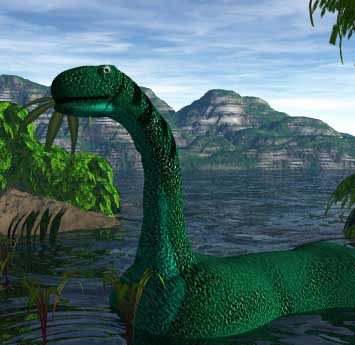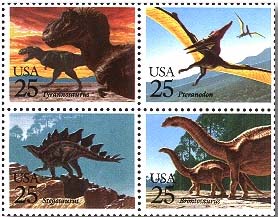|
What Happened to the Brontosaurus?
The Brontosaurus as Marsh envisioned him: wrong head, wrong name, wrong lifestyle.
Video: The Great Bone War or Requiem for a Brontosaurus There was a time when the dinosaur named Brontosaurus evoked images of a monstrous beast with four legs, a long, graceful neck dragging an even longer tail through primeval swamps. The meaning of the name, "Thunder Lizard," seemed perfect for an animal who must have shook the ground with every step he took. Thousands of children knew this dinosaur by that name. It even appeared as the symbol of a major oil company and starred as one of four ancient, extinct reptiles featured on U.S. postal stamps. Since the 1980's, however, this name has disappeared from books and museum exhibits about dinosaurs. The famous beast was suddenly gone. Surprising, however, in 2015 he may be making a comeback. Why did he leave, and now why has he now returned? Casualty of the "Bone Wars?" The Brontosaurus, a member of a family of dinosaurs that walked on four legs with long necks and long tails called sauropods, was the victim of a war that was played out over a hundred years ago. Starting in the late 1860's, two of America's most prominent paleontologists, Edward Drinker Cope and Othniel Charles Marsh, had a falling out. Cope claimed that Marsh had paid quarrymen in New Jersey to divert fossils they found for him to Marsh. Personal attacks between the men, thinly veiled as "scientific criticism," followed in articles that they wrote for publication. Later, each would send teams into the fossil fields of the West where they would fight over digging rights amid claims that the other side had destroyed or damaged fossils in order to block their rivals from getting a hold of them. One outgrowth of these "bone wars" was an unscientific competition between Cope and Marsh to see who could discover the most species of extinct beasts. In their rush to beat each other to the next find, the scientists often based their claims on incomplete or inaccurate data. In 1877 Marsh wrote a short two-paragraph article for the American Journal of Science. The article, entitled "Notice of New Dinosaurian Reptiles from the Jurassic Formation," didn't have illustrations and included only a description of the animal's vertebral column, but he named the creature anyway. Marsh estimated that the Apatosaurus, meaning "deceptive lizard", was fifty feet in length. Marsh followed this article with another one in 1879 where he showed a sketch of the creature's pelvis, shoulder blade and vertebrae. In that same year, in another short article in American Journal of Science, Marsh claimed finding another dinosaur based on a description of the pelvis and vertebrae. He named this one Brontosaurus and estimated it to be seventy to eighty feet in length. The Brontosaurus soon went on to become one of the most famous dinosaur species of all time. A nearly complete skeleton found by Marsh was mounted in Yale's Peabody Museum. There it captured the public's imagination as did a beautiful illustration Marsh published in The Sixteenth Annual Report of the US Geological Survey, 1895. The Yale skeleton was the first sauropod dinosaur put on display anywhere in the world when it was mounted in 1905 and the animal was clearly labeled as a "Brontosaurus." In contrast the few unspectacular Apatosaurus bones Marsh found were never augmented with a full skeleton. Marsh's 30-Ton Mistake In his rush to beat Cope, Marsh had made a mistake, however. The Apatosaurus was not a separate species, but simply a juvenile example of Brontosaurus. In 1903 Elmer Riggs of the Field Museum in Chicago was studying Marsh's work when he found this mistake: ...the writer is convinced that the Apatosaur specimen is merely a young animal of the form represented in the adult by the Brontosaur specimen. Riggs, following the naming rules for animals that applied at the time added: ...In view of these facts the two genera may be regarded as synonymous. As the term"Apatosaurus" has priority, "Brontosaurus" will be regarded as a synonym. Despite the poor Brontosaurus losing its official status very early in the 20th century, the name continued to be used in popular books, semi-technical articles and even on museum displays. The Brontosaurus became the symbol for Sinclair, a petroleum supplier, and a full-sized model made its appearance at the oil company's exhibit at the 1964-65 New York World's Fair. The question of the popular Brontosaurus name verses the technically-correct Apatosaurus name came to a head in 1989 when the U.S. Post Office decided to release a set of four stamps illustrating "dinosaurs." One in the series was a picture of a large sauropod labeled Brontosaurus. This upset some dinosaur enthusiasts who accused the Postal Service of promoting scientific illiteracy, an ironic accusation given the number of museums that had the animal mislabeled for decades. While there was a hue and cry over the Brontosaurus name, few even mentioned the other, more glaring error, which was the inclusion of a Pteranodon (a flying reptile) in a set of dinosaur stamps. By definition dinosaurs do not have wings. A few prominent people came to the defense of the Brontosaurus and the Postal Service. Stephen Jay Gould, the noted biologist, pointed out that the issue was a tempest in a teapot in his famous article, "Bully for the Brontosaurus" written for Natural History magazine. Robert Bakker, the celebrated paleontologist and curator of the Tate Museum in Casper, Wyoming, also continues to use the popular Brontosaurus label instead of Apatosaurus. To add insult to injury, the poor Brontosaurus not only got a name change, but it was discovered that he had the wrong head, too. One item that was not found in the excavation with Marsh's Yale skeleton was a skull. Marsh mounted a head found at a different location to complete the exhibit. For many years scientists suspected that Marsh had gotten the wrong skull, but it wasn't until 1970 that two scientists, John McIntosh from Wesleyan University and David Berman of the Carnegie Museum, proved it. The head that Marsh had mounted was from another sauropod named Camarasaurus. The proper Brontosaurus/Apatosaurus skull actually had a slightly longer snout and looked a lot like the skull of another sauropod called Diplodocus. Thunder Lizard's Revised Lifestyle Marsh's Brontosaurus would wind up getting both his name and his head changed, but it isessentially still the same animal. It it wrong to refer to an Apatosaurus as the Brontosaurus? Not really. The popular synonym has been around for many years and its meaning, "Thunder Lizard," is highly descriptive to the sound the animal made. What sense does the name "deceptive lizard" make? How deceptive can a 70-foot long, 30-ton animal be? Much more important than the question of names is what we know about how the animal actually lived. Today, scientist's vision of the habits and habitat of the Apatosaurus are quite different than what Marsh and other early paleontologists had thought. Early analysis suggested that the animals must have been weak because their small heads could only chew the minimum amount of food necessary to fuel such a big body. So weak, in fact, that large sauropods were thought to be slow, unable to lift their bulky tails off the ground and only able to support their massive weight by living in shallow lakes and swamps where water floated their bulk. Paleontologists like Bakker showed that this image was wrong. No Apatosaurus skeleton has been found in an ancient body of water and its feet were not at all suited for walking through marshy and muddy ground. In fact, Bakker notes in his book Dinosaur Heresies, an analysis of changes in geology over time suggest that large sauropods moved out of areas as they became wet: they didn't like swamps at all. Also, a careful reconstruction of the tail shows that it was probably held aloft and could be swung back and forth, perhaps for defense. The sauropod's small head was not a limit on how much it could eat because the animals didn't chew their food in their mouth. Like many modern birds (and crocodiles), they grind up food in a lower part of the stomach called the gizzard. Researchers have recovered stones from sauropod excavations that the animals swallowed and that lay in the gizzard to aid in the the grinding process. Because of this Bakker has suggested these huge animals may have been so active that they could stand on their rear legs to reach high plants or engage in mating battles. So, even if the poor Brontosaurus's name was a casualty of the "bone wars," at least eventually paleontologist have gotten his lifestyle right. But is the Brontosaurus Back? In 2015 a study led by Emanuel Tschopp, a vertebrate paleontologist at the New University of Lisbon, took a new look at a number of sauropod fossils. The scientists analyzed 477 physical features of some 81 specimens by traveling around to museums across the world in an attempt to understand the relationships between them. They found evidence that the Brontosaurs was indeed a separate species from the Apatosaurus after all. "The Brontosaurus can be distinguished from Apatosaurus most easily by the neck," said Tschopp," which is higher and less wide." In fact, the study suggests there might actually be three species of brontosaurus: Brontosaurus excelsus, the one Marsh first found, as well as a Bontosaurus parvus and a Brontosaurus yahnahpin. Even though it may take more than one study to convince some scientists, it seems likely that the venerable sauropod may soon find his name back in museums to the delight of dinosaur fans around the world. The set of U.S. Postal stamps that ignited the controversy in 1989. (Courtesy US Postal Service)
Copyright Lee Krystek, 2002-2015. |


